|
TennisOne Lessons
The One Handed Topspin Backhand Doug King The backhand is probably the most natural stroke in tennis. Of course you hear that, and most experienced players will agree, but let's try to understand why that is, as I believe it will shed light on the huge amount of misinformation and confusion that dominates this game. And although I say the backhand is the most natural of shots, I will argue that it is because of the backhand that we are so totally perplexed by what can otherwise be quite simple. The True Nature of Contact (The Transfer of Power)
A much more effective power source is leverage and torque which comes from coil and flex starting from the center and working outward and is based upon stored energy. This energy is dependent upon the ability of the racquet to connect with the ball so that the stored energy that is saved in the coil and flex of the body can be transferred efficiently to the ball. The longer the contact the more opportunity for the force of the body to be transmitted to the ball. The quality of this connection is directly related to the amount of energy that can be delivered to the ball from the body. We think of contact as a moment, a single collision between the ball and the racquet, when in reality, we should consider it as a process, a merging together of the ball and the racquet. How it becomes a process and not an instant is by controlling the forces that first, rebound the ball away from the racquet and second, allow the racquet to follow the departing ball. Ideally, for good contact, we have forces coming into contact that do not make the ball leave too quickly (what I refer to as stay) and then an ability to move the racquet in a way to stay with the ball as it does leave (what I refer to as follow). Acceleration is the key to this equation since acceleration is the change of speed in the racquet, and this is exactly what is required to create longer contact, slow into the ball and then fast with the ball. It is the production and timing of this acceleration that is tricky. A swing that moves at an even speed, no matter how slow, will never produce much "hold" because hold is created by acceleration. But when it is properly learned, the production of this kind of power is what is essential for everything else to do its job - from feet to eyes to mind. The Load, the Lag, and the Stay
To sum up, as the elbow and shoulder move forward into the hit there is a simultaneous flexing back and coiling in the forearm that creates a "lag" or pocket of dead space that naturally slows the speed of the racquet in the backswing. This is why you see the characteristic fluid "wag" in the arm by top players just before they hit the ball. We call this Loading. This wag is part of the rhythmic loading of the entire hitting side (the turn of the hips and shoulders, the lift of the elbow, the bend of the knees and the waist - what I call the Power Cord) and is what slows the racquet and angles the approach of the swing to the ball. This helps to monitor the amount of stay on contact, all the while building stored energy into the contact to be used for the transfer of power. It is as though the ball is captured in a pocket of flex (the power pocket) and then shot out by pulling the on the ends of the pocket. The Leave and the Follow
Proper acceleration will not only provide leave but will also allow follow with the departing ball. The follow is produced by rapid extension of the arm through contact. This extension should be accompanied with a turn or controlled brush of the ball as this creates an angle of approach lessening leave, increasing follow, and improving connection. In fact, when hitting a faster ball there is usually more turn of the ball and less forward thrust from the extension. At the same time you are following you must be sure you hold the racquet in alignment to the target for maximum control. To do this, the tip of the racquet must be held back as the elbow extends and the shoulder lifts and pulls back . It is almost as though the racquet is like a sword being drawn from its sheath. The tip must be held back to avoid slap. The force of the uncoiling and extension should never be totally released - that is the whip should never really "snap" as this would whip the tip of the racquet forward too far, creating too much power and not enough hold. The stroke is built upon flex and coil of the Power Cord creating stored energy that allows a more flexible approach to the ball and produces an ideal combination of stay, leave, and follow. The buildup and release of power varies depending upon the variables of the game (time, space, the forces on the ball, and the desired goal) and, to some extent, on a player's individual style and grip.
This formula of "contact" (stay-leave- follow) is perfectly suited to torque and flexion and leverage and stored energy. Flex and coil create more angles coming into the ball and compression into the body, which helps to slow the racquet, contributing to STAY. It also provides quick acceleration through the release of the stored energy (like a compressed spring when released) through torque and extension (follow). Torque also allows natural turning of the ball to further manipulate the application of force on the ball. Leverage provides the driving force of the body behind the hands. It is essential to differentiate between Body Acceleration ( the pull of the Power Cord ) and Racquet Acceleration (the acceleration of the hand - not the tip of the racquet). People are far too focused on racquet acceleration. When the racquet accelerates too much or too soon it disconnects the racquet from the ball before the body has a chance to release it's power into the ball (which is possible only through connection). The correct feel is to let the racquet "stay on the ball" while the body accelerates (Power Cord pull) and then the racquet acceleration follows soon thereafter, which is usually reduced to a simple turn of the ball. When you establish longer contact to the ball (more connection), you can exert more leverage (weight shift) on the ball through torque, and flexion. We call this "getting your body into the ball" and this can only happen when the racquet is connected with the ball. For years, hitting straight through the ball has always been considered the safest, most effective way of stroking the ball. But in reality, this can be a very inefficient way of contacting the ball in terms of utilizing the leverage of the body.
Swinging in exactly the same direction as the oncoming ball simply rebounds the ball away from the racquet faster, creating less connection. Placing the racquet behind the ball and driving through a single point on the ball towards the target is not the most efficient means of transferring power and can result in poor contact (little connection). If the acceleration of the racquet is put onto more tangential planes (brushing up or down, or sideways) then the contact on the ball occurs over a larger surface area creating more connection. Thus, the flex and coil motion based on a whip principle focuses the transfer of power into a broader area of the ball by driving up from low to high for topspin. This, when done at the correct angle, actually creates more connection to the ball and more control. That is because the ball and the racquet don't "collide" as much as they merge together. For some players (Federer, for example) nearly all of the forward and backward motion of the racquet, by the time it actually reaches contact, is siphoned down through the whip principle, to a lift of the racquet. The racquet face may adjust from more open to more closed on a topspin, which creates more forward momentum and adds power. This is why the racquet face is sometimes closed after contact on topspins. On the final approach to contact the racquet face must be able to make micro adjustments to accommodate the many variables on the ball (speed, spin, angle, height). The racquet is not "hitting" the ball on a point as much as it is "conforming" to the shape of the back of the ball to produce the desired spin and trajectory. Time and Space Some will say that we don't have time or control to turn the moment of contact into a "process" - that science also shows this doesn't happen. To this I would say two things. One is that I know the ball must come to a stop when it changes directions. Two, when I see a still picture of the ball at contact and I can see the amount of compression of the ball and the deflection of the strings, I cannot be convinced that there is not a discernable change occurring that my own senses validate.
Time and space are relative things. If you have to brush your teeth and shave in only 60 seconds, a minute can seem like a very short time, but when you have your hand on a hot burner a minute can seem very long indeed. When we are extended and tense on our backswings, we lose time and we are slow and therefore we feel hurried. This reinforces our belief that we don't have much time, and then we swing the racquet back even faster the next time, only making matters worse. Instead, if we simply react in a timely manner and we stay relaxed and don't extend as much, we can produce power in much less time and a much shorter space, making everything more manageable and effective. By doing this we can actually slow down the game. By reaching out to the target we assume we can hit "through" the ball and achieve better contact. The opposite actually happens. The ball simply rebounds off the racquet more quickly and with less control. This is exactly what a baseball pitcher does when he "steers" a pitch. He overextends to the target and holds the ball too long thereby losing power and control. Instead one should focus on brushing or turning the back of the ball without reaching way out to the target. This gives you better focus on the ball in the true hitting zone instead of trying to extend to a target. You will achieve better connection since you have less rebound and you have more of the ball to work with as you turn the ball. The result is you expend more energy directly into the ball rather than spraying it out to the target. This is why Federer is so good. He never gets distracted by the target, either looking or overextending to it. By focusing more on the back of the ball in a smaller area you can actually make the ball appear bigger and slower - it is as though the ball sits still and you work on the back of the ball in that specific area instead of focusing on one point on the ball and pushing on that point and out to a target (the old hit a series of balls approach). Visualizing behind the ball and then out in front of the ball can actually distract you from the ball itself. Watch the pros. They look fluid and unhurried and yet have explosive quickness without any loss of control. This can be done by almost everyone. Two keys are relaxed energy and the proper generation and transfer of power.
Leverage and the Body There are two things that can go behind the racquet - the body and the hand. This is one of the most critical aspects of power and it is commonly overlooked. Most of the so called faults of falling back on shots and stepping back are usually the correct adjustment necessary to add power by putting the body in a position of more support to the hand and increasing leverage. When we talk about power, we usually consider backswing and swing speed and I don't know what else but we fail to look at these two things - (1) hand position on the racquet and (2) body position relative to the hand. The more of the hand and the body behind the racquet the stronger the position, and the more power available. The forehand and the backhand are identical in almost all respects except that the position of the hand and the body have been reversed - that is, the hand is in the back of the racquet on the forehand (strong) and the front of the racquet on the backhand (weak). The body is in front of the racquet on the forehand (weak) and in back of the racquet on the backhand. This is why the backhand feels so weak to beginning players who have not yet developed strength and the forehand feels strong. The hand is better situated for the forehand. This strong hand position allows players much more leverage in a wider range of positions such as when the body is out of position. In fact, you can even step forward and still the hitting side is in front. The relationship of the hand and the body to the racquet is the most important thing to understand when comparing the two strokes. If you swing at the ball too much you will never create connection. When you come into the ball at the same speed as you leave (what we typically think of as a smooth swing) the result is no STAY or FOLLOW on the ball, only LEAVE. We call it SLAPPING. When there is no acceleration (slow to fast - stay to follow) there is no connection. Acceleration is connection!. It doesn't matter how slowly you swing you will never achieve control of the ball this way - just weaker uncontrolled shots. Long, slow, smooth swings on horizontal planes are devoid of acceleration. They are a thing of the past, the dinosaurs of professional tennis. Today's swings keep the large muscle groups (the CORE) doing the powering and the small muscle groups (the hands and the feet) doing the fine adjusting. Getting the racquet back fast and then following through with the racquet is the exact opposite formula you want to use if you want to create connection and exercise leverage from the body. People think the old flat strokes were smooth. To me they were tentative. Today's strokes are bursting with fluid energy, confidence and technique. Can they also be tempered with clear vision and good judgment? That is another question. When you first try to move your grip over to a stronger position you will probably hit the ball into the net. That is because when you make a grip change it will close the face of the racquet. To adjust, tilt your upper body back to square the face of the racquet. Tilt back! Are you crazy! I am crazy, crazy from people saying "lean into the ball." When contacting the ball, the hips will drive forward as the shoulder is lifted back, so in reality there is still forward drive even though you are feeling like you are going back. And remember - back is good (behind the racquet).
Look at Barry Bonds or Tiger Woods or Roger Federer if you need convincing. Do they lean into the ball? No - they get behind their hands. All the great ones do, even all the near greats, and the damn good ones too. The "knuckles on top" grip will provide leverage by getting the racquet in front of the body and more of the hand behind the handle. It will create upward brush on the ball (turning) by setting contact at the vertical lift segment of the swing plane (out in front of the body). These are critical components for controlled power; strong body connection to the hand (leverage) and better connection of racquet to ball (transfer of power). Henin (below right) starts with quick feet and hands. Almost immediately she changes grips. Then she begins a smooth coil of the body (allows eyes to remain "connected" to ball) facilitated by light feet and loose hips.
Notice how the left hand keeps the racquet forward here rather than pulling the racquet back. The energy should not go to the racquet at this point. The shoulders will lift, turn, and drop, as the knees follow a similar pattern, allowing adjustment to the ball on a vertical plane and further building stored energy (flex and coil) into the Power Cord. Notice the arm cannot extend away from the body on the backhand side because of the body position (hitting side to the net). This is a fundamental reversal from the forehand, where the arm can extend in the backswing resulting in a total loss of stored energy. This is what makes the backhand the more "natural" stroke. The arm naturally coils and compresses into the body creating a better connection between the arm and body and naturally relying on stored energy as opposed to centrifugal force from extension, as is more likely on the forehand.
At the final moments of approach the upper body stops it's forward movement towards the ball and instead the right shoulder starts to lift and pull back. Most people make the mistake of continuing the forward shift and turn of the shoulders resulting in a flat push on the ball and a poor release of the stored energy. The pull back of the right shoulder creates a straightening of the Power Cord and drives the hips into the shot while the racquet can brush and turn the ball. The racquet head is held back as long as possible which stores the energy and assures proper alignment of the racquet face through contact. The energy is never completely released through the wrist as this would create more forward momentum resulting in slap and a loss of racquet face alignment. Instead the racquet face is directed on more of a vertical plane to maximize connection to the ball (turning the ball) resulting in more efficient transfer of the stored energy of the body into the ball.
Get the feel of using the racquet face to roll the ball to your target (like the big ball) instead of trying to hit through the ball and out to your target. Do not let the tip of the racquet swing forward so that it points out into the court. The swing is in the body, the pull up and back of the shoulder and the drive of the hip - the pull of the POWER CORD!
The racquet aligns to the ball and holds connection to it. Not every shot requires this kind of power and not every shot is an opportunity to execute this stroke. If, however, you understand the principles of stored energy from the body and connection of the racquet to the ball as a means of transferring that energy, you will have made the most important distinction in the modern game versus the old style of play. Your comments are welcome. Let us know what you think about Doug King's article by emailing us here at TennisOne.
Doug is one of the country's leading tennis teaching innovators. Founder of Acceleration Tennis, a revolutionary teaching system, King is leading the way in reinterpreting the traditional tennis model. For more information on Acceleration Tennis please e mail King at dking@meadowood.com. |
||||||||||||||||||||


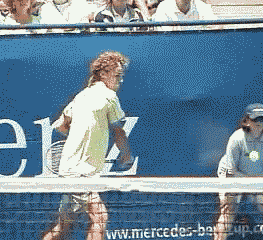
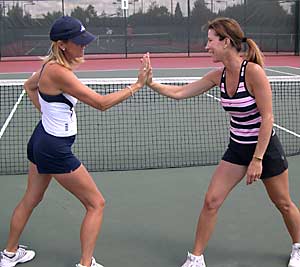
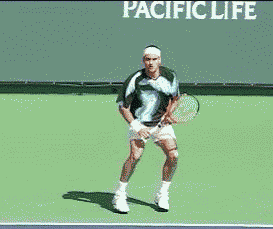

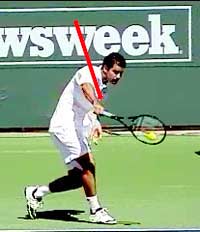
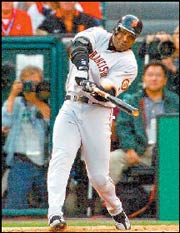
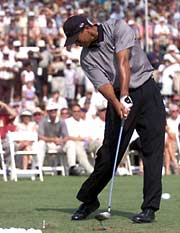
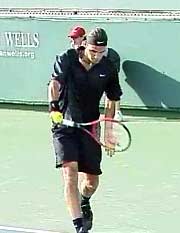

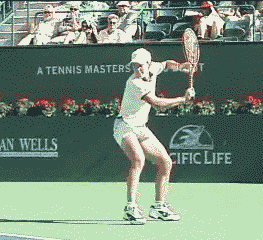
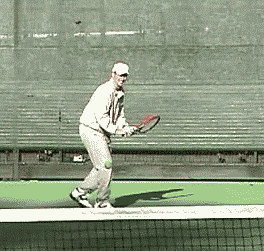
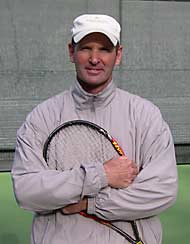
 Doug King studied with legendary tennis coach Tom Stow and was a
former California State Men's Singles Champion
and the former number one men's player of Northern California.
Doug King studied with legendary tennis coach Tom Stow and was a
former California State Men's Singles Champion
and the former number one men's player of Northern California.